Part I - Essence of the Sutra
1. Essence of the Sutra
1.1 Five layers of the meaning
1.2 The Title of the Sutra
1.3 The Essence of the Sutra
1.4 The Guiding Principle
1.5 The Function of the Sutra
1.6 The Forms of the Buddhist Teaching in this Sutra
1. ESSENCE OF THE SUTRA
1.1 Five layers of the meaning
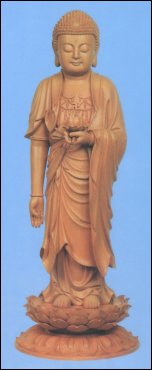 The
Buddha took pity on the multitudes of deluded sentient beings, and
put forth transformative teachings according to the various potentials
of these deluded sentient beings. Although these teachings all derive
from the same source, many different expedient methods are employed. The
Buddha took pity on the multitudes of deluded sentient beings, and
put forth transformative teachings according to the various potentials
of these deluded sentient beings. Although these teachings all derive
from the same source, many different expedient methods are employed.
Among all these expedients, if we seek the most direct and the most complete, none is a good as seeking birth
in the Pure Land through Buddha-remembrance (Buddha recitation). If we seek the simplest and most reliable among
all the methods of Buddha-remembrance, the best is to develop faith and vows and to concentrate on reciting the
Buddha-name.
This is the reason that the ancients took the Amitabha Sutra as their daily study guide, through three Pure
Land scriptures have circulated side by side in the world over the generations. The Amitabha Sutra shows that the
method of reciting the Buddha-name applies to people of high, medium, and limited capacities. It encompasses both
the level of phenomena, and the level of inner truth (noumenon), omitting nothing. It embraces both Zen Buddhism
and Scriptural Buddhism, and leaves nothing out. This method is indeed inconceivably great!
Over the generations, since ancient times, there has been no lack of people to comment upon and explain the
Amitabha Sutra. Over time, many of these commentaries have fallen into oblivion and nowadays not many survive.
[A generation ago], Master Chu-hung of Yun-chi wrote his extensive and subtle commentary, and my own teacher's
Master, Yu-hsi, wrote Complete Middle Path Commentary, which is profound and highly learned. [These two commentaries]
are like the sun and the moon: all those with eyes see them. But [in these two commentaries] the literary style is
elaborate and the levels of meaning are complex. Their ultimate reaches are unfathomable.
Therefore I have put aside all qualms about my own mediocrity and ignorance and composed another commentary,
explaining the essential points of the Amitabha Sutra. I would not dare to diverge from elders Chu-hung and Yu-hsi
just to be original, nor would I force myself to agree with them for the sake of agreement. When I look upon their
example, it is as if lofty peaks surround me. Even though my commentary in no way fully describes the true realm of
the Pure Land tradition, I must not fail to give every one of you a personal vision of it.
When one explicates the text of the Amitabha Sutra, there are five layers of profound meaning:
1.2 The Title of the Sutra
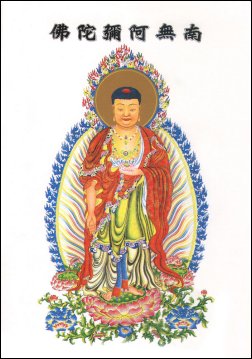 First,
there is the title of the sutra to explain. First,
there is the title of the sutra to explain.
[This scripture is called "The Amitabha Sutra Spoken by Buddha".] This sutra takes its title from the one
who expounds it and from the one of whom he speaks. Buddha is the master teacher, the one who expounds the
scripture in this world, that is, Sakyamuni. By the power of his vows of great compassion, he was born here
in the world of the Five Turbidities. As the one who was first to awaken, his mission was to bring enlightenment
to those who were to awaken later. Buddha is the one who knows all and sees all.
Buddha speaks the sutra with joy in his heart. Buddha's intention is to liberate sentient beings. Since the
potential of sentient beings to achieve enlightenment is ripen, Buddha expounds for them these Pure Land teachings which are difficult to believe, and enables his
listeners to reach ultimate liberation. That's why he is filled with joy.
Amitabha Buddha is the one Sakyamuni refers to in the sutra. Amitabha is the guide of the Pure Land. By the
power of his forty-eight vows, he receives the sentient beings who have vowed to practice Buddha-remembrance by
invoking the Buddha-name and enables them to be born in the Land of Ultimate Bliss, and never fall back from there.
The Sanskrit name" Amitabha" means "Infinite Life" and also "Infinite Light". The essential point is that everything
about him is infinite: his merits and his wisdom, his supernatural powers and his power in the Path, his embodiment
and his environment, his work in expounding the Buddhist teachings and liberating sentient beings.
A sutra is any teaching from the golden mouth of a Buddha.
These terms taken together make up the title of the scripture: The Amitabha Sutra Spoken by Buddha. The three
categories -- teachings, practices, and inner truth (noumenon), which each sutra should have -- can each be
explained in both general and particular senses, as set out in the Tien-tai system.
1.3 The Essence of the Sutra
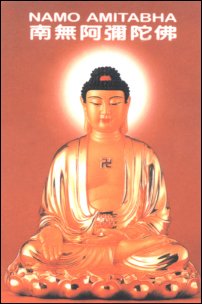 Second,
there is the essence of the sutra to discern. Second,
there is the essence of the sutra to discern.
The true essence of all the Great Vehicle (Mahayana) scriptures is Absolute Reality (Real Mark) itself.
What is Absolute Reality? It is the Pure Mind of sentient Beings. This mind is not inside, not outside, and not
in between. It is not past, not present, and not future. It is not green or yellow or red or white, long or short
or square or round. It is not a scent, not a flavor, not a texture, not a mental object. When we search for it,
we cannot find it, but we cannot say it does not exist. It creates all worlds and all realms, but we cannot say
it exists. It is detached from conditioned thoughts and discriminations, from all words and characteristics, but
conditioned thoughts and discriminations and worlds and characteristics do not have any separate identity apart
from it.
Essentially, absolute reality is detached from all characteristics, but merged with all phenomena. Being detached
from characteristics, it is formless, and being merged with all phenomena, it gives them all their forms. For lack
of an alternative, we impose on it the name "absolute reality" [i.e., Mind, Real Mark, Buddha Nature].
The essence of Absolute Reality is neither quiescent nor aware , but it is both quiescent and yet ever shining
with awareness, both shining with awareness and yet ever quiescent. In that it is shining with awareness but
quiescent, it is called the Land of Eternally Quiescent Light. In that it is quiescent but shining with awareness,
it is called the pure Dharmakaya (Dharma Body). Aware quiescence is called the Dharmakaya, the Dharma Body of all
the Buddhas. Quiescent awareness is called the Sambhogakaya, the Reward Body.
[For the Buddhas] quiescence and awareness are not two, bodies and lands are not two, what is inherent and what
is cultivated are not two, true essence and responsive function are not two -- everything is absolute reality.
Reality and appearances are neither two nor not two.
Therefore, the essence of reality as a whole, acts as both the environment that surrounds sentient beings and
as their very bodies. It acts as both the Dharma Body and the Reward Body of the Buddhas. It acts as both self and
others.
Thus the one who speaks the sutra and the one who is spoken of, the Buddhas that can deliver sentient beings
and the sentient beings who are delivered, the ability to believe and that which is believed in, the ability to
take vows and that which is vowed, the ability to concentrate on the Buddha-name and the Buddha-name which is
concentrated upon, the ability to be born in the Pure Land and birth in the Pure Land itself, the ability to
praise the Buddhas and the Buddhas who are praised - all of these are the imprint of the "true seal" of Absolute
Reality. In other words, the True Mind (Bodhi Mind) sentient beings is the essence of all Mahayana sutras.
1.4 The guiding principle
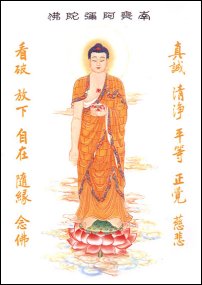 Third,
there is the guiding principle to explain. Third,
there is the guiding principle to explain.
The guiding principle is the essential route for cultivating practice, the key link for understanding the
essence [of our mind], the guiding framework for the myriad practices. When you hold up a net, the mesh opens up.
When you lift the collar of a shirt, the breast and sleeves come too. Thus, after explaining the essence, of the
sutra, we must discern the guiding principle. The essential principle for cultivation in this sutra is to develop
faith and vows and to recite the Buddha-name. Without faith, we are not sufficiently equipped to take vows. Without
vows, we are not sufficiently equipped to guide our practice. Without the wondrous practice of reciting the
Buddha-name, we are not sufficiently equipped to fulfill our vows and to bring our faith to fruition.
The sutra first sets forth the pure environment of the Land and the exalted bodies of its inhabitants in order
to engender faith in us. Next it urges us to take vows to give guidance to our practice. Then it teaches the
practice of reciting the Buddha-name as the route of direct ascent with no falling back (non-retrogression).
Faith means having faith in oneself and faith in other (Buddha and Bodhisattvas). It means being sure about
cause and effect, about phenomena and inner truth (noumenon).
Vows mean feeling aversion to the mundane world and detaching from it. Vows mean gladly seeking the Pure Land of
Ultimate Bliss.
Practice means persisting in the practice of reciting the Buddha-name single-mindedly and without confusion
(with one-pointedness of mind).
[Faith]. Believing in ourselves means believing that the True Mind is not a physical manifestation, and not
the reflection of entangling objects, that it extends through time without any before or after and through space
without any boundaries. Though it follows causal conditions all day long, it never changes.
All of space in the Ten Directions and all the worlds countless as atoms are originally things created by this
Mind of ours. Although we are deluded and confused, if for a single moment we return to this Mind, we are sure to
be born in the Land of Ultimate Bliss originally inherent in our own mind, and be troubled no more by worry and
doubt. This is called "believing in ourselves".
Believing in others means having faith that the Tathagata Sakyamuni certainly did not lie, and that the World
Honored One Amitabha certainly did not take his vows in vain. It means being certain that all the Buddhas of all
the directions never equivocated, and it means following the true teachings of all the enlightened ones. It means
establishing our will to seek birth in the Pure Land, and being prey no more to doubt and confusion. This is
called "believing in others".
Believing in the causal basis means having faith that even Buddha-name invocation carried out in a scattered
confused state of mind is still a seed of enlightenment, and that this is even more true of invoking the Buddha-name
single-mindedly and without confusion. [If we sincerely and single-mindedly invoke the name of Amitabha Buddha], how
can we fail to be born in the Pure Land? This is called "believing in the causal basis", i.e., that recitation is
the cause of enlightenment.
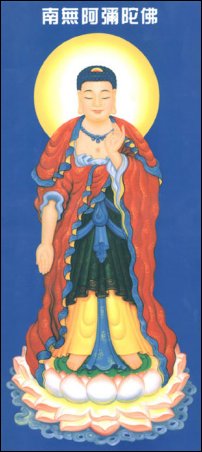 Believing
in the result means having deep faith that all the spiritually superior
beings assembled in the Pure Land have practiced the Buddha Remembrance
Samadhi, the meditative concentration that comes from reciting the
Buddha-name. When you plant melon seeds you get melons, and when you
plant beans you get beans. [Effect follows causes] like a shadow follows
a physical shape, like an echo responds to a sound. Nothing is sown
in vain. This is called "believing in the result". Believing
in the result means having deep faith that all the spiritually superior
beings assembled in the Pure Land have practiced the Buddha Remembrance
Samadhi, the meditative concentration that comes from reciting the
Buddha-name. When you plant melon seeds you get melons, and when you
plant beans you get beans. [Effect follows causes] like a shadow follows
a physical shape, like an echo responds to a sound. Nothing is sown
in vain. This is called "believing in the result".
Believing factual phenomena means having deep faith that although
this mind of ours is ephemeral, the worlds of the Ten Directions based
on it are inexhaustible. The Land of Ultimate Bliss really does exist
ten billion Buddha-lands away, adorned with ultimate pure adornments.
This is not some fable from Chuang-tzu. This is called "believing
factual phenomena".
Believing in inner truth (noumenon) means having deep faith that the ten billions Buddha-lands (worlds) are in
reality not outside our Mind. Since there is really nothing outside of this Mind, we have deep certainty that the
whole assembly of beings and surroundings in the Western Paradise is a set of reflections appearing in our mind.
All phenomena are merged with inner truth, all falsity is merged with truth. All practices are merged with True
Nature. All others are merged with oneself. Our own inherent mind is all-pervasive, and the Buddha- mind is also
all-pervasive, and the true nature of the minds of sentient beings is also all-pervasive. It is like a thousand
lamps in one room, each of whose light shines on all the others and merges with the other lights without any
bstruction. This is called "believing in inner truth" (Noumenon).
[Vows]. Once we have these forms of faith, then we must understand
that the mundane world is the defilement brought about by our own
minds, and we must detach from it; the Pure Land is the purity brought
about by our own minds, and we must joyously seek it. We must renounce
defilement utterly, until there is nothing that can be renounced,
and we must grasp purity utterly, until there is nothing that can
be grasped.
Therefore the commentary Miao-tsung said:
If you take grasping and rejecting to the limit, they are not in a different groove than not grasping and not
rejecting. If you do not engage in grasping and rejecting, and only value not grasping and not rejecting, this is
a form of clinging to inner truth and abandoning phenomena. If you neglect the phenomenal level, then you are not
complete at the inner truth level. If you arrive at the point where all phenomena are merged with inner truth,
then both grasping and rejecting are also merged with inner truth. Sometimes grasping, sometimes rejecting, nothing
is not the Realm of Reality.
[Practice]. When we speak of concentrating on the Buddha-name single-mindedly, we are referring to recitation
with a mind that is unified and not chaotic. To invoke the Buddha-name is to invoke the qualities of Buddhahood.
Since the qualities of Buddhahood are inconceivable, the Buddha-name itself is also inconceivable. Thus, even if
we recite the Buddha-name in a scattered state of mind, it is still a seed of enlightenment, while those who recite
single-mindedly will immediately ascent toward enlightenment without falling back.
Many sutras teach Pure Land practices of various kinds: contemplating the image of Buddha, contemplating the
concept of Buddha, doing prostrations, making offerings, practicing the five forms of repentance and the six forms
of mindfulness, and so on. If you consummate any of these practices, and dedicate the merits toward rebirth in the
Pure Land, you will be born there. The method of reciting the Buddha-name is the one that is all-inclusive,
embracing people of all mentalities and the one that is easiest to practice. This is why the compassionate one,
Sakyamuni Buddha, explained it to Shariputra without being asked. Reciting the Buddha-name can be called the number
one expedient among all the expedient methods, the supreme complete truth among all the complete truths, the most
perfect of all the perfect teachings.
There is a saying: "If a purifying pearl is put into dirty water, the dirty water cannot but be purified. If the
Buddha-name is put into a chaotic mind, even that chaotic mind cannot fail to become enlightened." Reciting the
Buddha-name with faith and vows is a true cause for the Supreme Vehicle. The Four Pure Lands [the Land Where Saints
and Ordinary Beings Dwell Together, the Land of Expedient Liberation, the Land of Real Reward, and the Land of
Eternally Quiescent Light] are the wondrous fruits of the Supreme Vehicle. If you have the causal basis, then the
result is sure to follow.
Therefore, faith, vows and reciting the Buddha-name are the true guiding principles of the Amitabha Sutra.
The characteristics of the Four Pure Lands are described in detail in the Miao-tsung commentary and in the book.
An explanation of the Brahma Net Sutra, and I will not explain them in full here. Later on I will give a brief
account of them as I explicate the text.
1.5 The Function of the Sutra
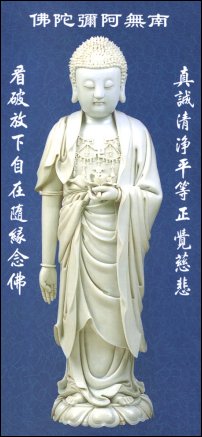 Fourth,
there is the sutra's function. Fourth,
there is the sutra's function.
The powerful function of this sutra is to enable us to be reborn in the Pure Land and never fall back. Rebirth
in the Pure Land can be categorized in terms of the Four Pure Lands, and also into Nine Lotus Grades in each Land.
Here I will give a brief explanation of the characteristics of the Four Lands.
If you recite the Buddha-name without cutting off your Delusions of Views and Thoughts, depending on how scattered
or how concentrated you are, you are reborn within the Nine Lotus Grades of the Land Where Saints and Ordinary Beings
Live Together.
If you recite the Buddha-name to the point of single-mindedness (phenomenal level), your Delusions of Views and
Thoughts are cut off and you are reborn in the Land of Expedient Liberation of Arhats and Pratyei Buddhas.
If you recite the Buddha-name to the point single-mindedness (noumenon or inner truth level), and you smash from
one to forty-one levels of ignorance and delusion, then you are born in the Land of Real Reward where Bodhisattvas
live.
However, if you recite the Buddha-name to the point where all forty-two levels of ignorance and delusion are
totally cut off, this is the highest reward and you will be reborn in the Land of Eternally Quiescent Light where
the Buddhas dwell.
The Amitabha Sutra has this kind of powerful function, which no text can describe. The powerful function of the
Amitabha Sutra should not be mentioned on the same day as the [far more pessimistic teaching] that lifetime after
lifetime of cultivation (with all the dangers of retrogression) is necessary before you can expect enlightenment.
How can Zen Buddhists and Scriptural Buddhists fail to consider this?
1.6 Forms of the Buddhist teaching in this Sutra
Fifth, there are the forms of the Buddhist teaching in the sutra to explain.
The sutra is contained in the Mahayana canon, Bodhisattva vehicle, and is "self-spoken" -- delivered by tbe
Buddha without being asked.
This sutra enables sentient beings with many karmic obstructions who live in the Dharma-Ending Age to make a
direct ascent toward enlightenment without falling back.
Thus, in the future when all the other sutras have perished, only this Amitabha Sutra will survive for another
century, to bring deliverance on a wide scale to sentient beings.
The Amitabha Sutra is a remedy for all sicknesses. It is beyond relativities, a perfect fusion, with
inconceivable power. The mystic treasury of the Flower Ornament (Avatamsaka) Sutra, the secret gist of the Lotus
Sutra, the essential teachings on mind of all the Buddhas, the compass of all the Bodhisattvas' myriad practices
- none of them is outside of this sutra. If I wanted to praise it at length, at the end of time I still would not
be finished. Those with wisdom must know this sutra for themselves.
|







